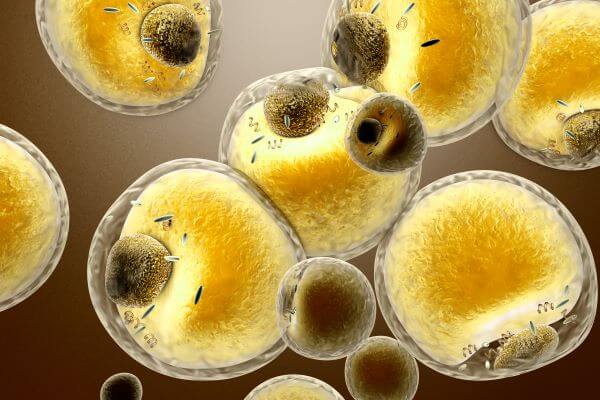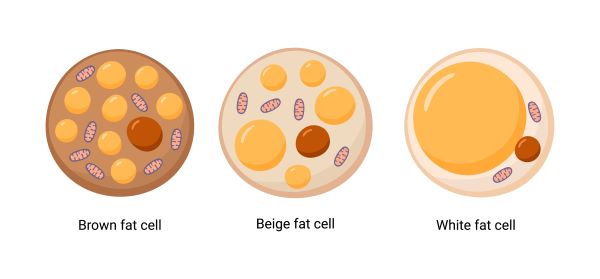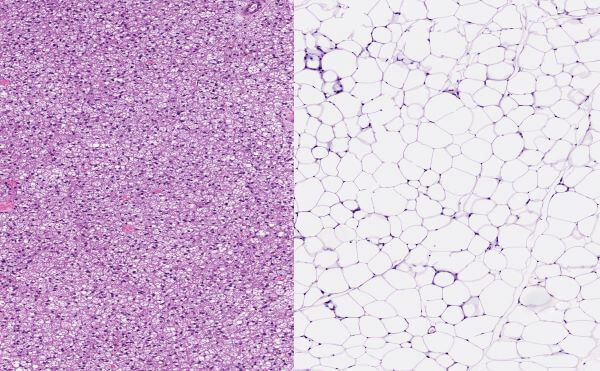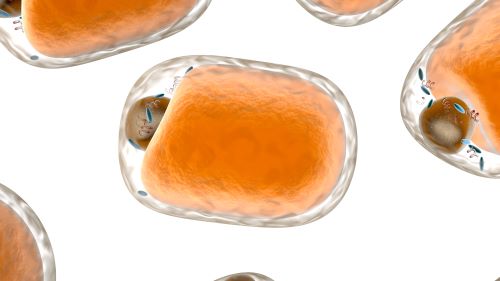Fat cells are the basic building blocks of fat tissue. Fat (or adipose) tissue is found throughout the human body and is concentrated beneath the skin, between the muscles, and around the internal organs.
The primary functions of fat cells are to store lipids for energy, to produce and secret hormones, and to release heat energy from lipids.

What Are Fat Cells?
Fat cells (AKA adipocytes or adipose cells) are the cells that make up the adipose tissue. Their main functions are to store energy in the form of lipids and to create an insulating layer beneath the skin for the conservation of body heat. Adipose tissue also insulates, cushions, and protects the internal organs.
Where Are Fat Cells Found?
Fat cells are primarily located beneath the skin, between the muscles, and around the internal organs. Adipose tissue under the skin is known as subcutaneous fat, and it mainly functions as an insulating layer and energy store. Fat tissue found between the muscles and internal organs is called visceral fat. Visceral fat also helps to insulate the body and prevent heat loss, whilst acting as a shock absorber to cushion and protect the organs.

Types of Fat Cells
There are three main types of adipocytes in vertebrates; there are white fat cells, brown fat cells, and beige fat cells. Different types of fat cells are found in different regions of the body and have different functions to one another.
White Fat Cells
Most fat in the human body is white fat tissue. White fat cells are highly specialized for fat storage and contain large lipid droplets. For this reason, they function as the body’s main energy reserve.
White adipose tissue also makes up the bulk of the insulating layer that lies beneath the skin and surrounds the internal organs. This layer is important for the conservation of body heat and, therefore, regulation of body temperature.

Brown Fat Cells
Brown adipose tissue also stores energy but, unlike white fat cells, brown fat cells are specialized to release energy in the form of heat. This process (known as thermogenesis) is ‘switched on’ in response to low external temperatures, and helps to maintain body temperature in cold conditions.
Brown fat cells are typically smaller than white fat cells and may contain multiple, small lipid droplets (rather than the single large droplet found in white adipocytes). They are also equipped with abundant mitochondria, which is how these cells get their brown color. During thermogenesis, the mitochondria in brown fat cells convert the chemical energy stored in lipids into heat energy. The heat is released from the fat cell and dissipates through the tissues of the body to maintain or raise its overall temperature.
Brown fat tissue is found in specific regions of the body, including between the neck muscles and shoulder blades, along the spinal cord, above the collarbone, and, sometimes, surrounding the internal organs.

Beige Fat Cells
Beige adipocytes are halfway between white and brown fat cells and have characteristics of both. They are found in similar areas to white fat cells and behave like white adipocytes until they are activated by low temperatures. When this happens, they go through a process called ‘browning’ and begin to behave like brown adipocytes (i.e., they start to burn lipids for energy).
Function of Fat Cells
Adipocytes are specialized to store fat and mainly function as a fuel reserve for the body. However, fat cells also have two other key functions, and these are the release of hormones and the production of heat.
Energy Storage
White fat cells function as a long-term energy store and are specialized to store lipids in the form of triglycerides. They are the body’s safety net against starvation and, in times of fasting, will release fatty acids and glycerol as fuel for the rest of the body.
When we consume excess calories, our bodies store more fats, and the size of the lipid droplets inside the fat cells increases. This gradually causes an increase in the mass of adipose tissue and can contribute to obesity.
The storage and release of fatty acids by white blood cells is controlled by hormones, such as insulin. The release of pancreatic insulin stimulates fat cells to take up and store triglycerides, while a drop in insulin levels causes fat cells to release their fatty acids.

Release of Hormones
Adipose tissue is more than just an energy-storing mass. It also functions as an endocrine organ, meaning it synthesizes and releases hormones. These hormones influence a wide range of biological processes in the body, including the regulation of food intake and control of sensitivity to insulin.
Heat Production
Like white adipocytes, brown fat cells store lipids for energy. However, they also have their own unique function, and this is thermogenesis: the use of lipids to produce heat.
Brown adipose tissue protects vertebrates from the cold and is ‘switched on’ by exposure to low temperatures. When this happens, the abundant mitochondria in brown fat cells are triggered to increase their oxidation of fatty acids, a process that ‘wastes’ chemical energy as heat. The heat produced by thermogenesis dissipates through the tissues surrounding the brown fat cells, helping to maintain the body temperature of the organism.

Structure of Fat Cells
Whether brown or white, all adipose cells consist of a large lipid droplet surrounded by a thin layer of cytoplasm and a plasma membrane. Each cell also contains organelles including a nucleus, Golgi apparatus, endoplasmic reticulum, ribosomes, and mitochondria. Brown fat cells contain lots more mitochondria than white fat cells do, which is what gives their lipid droplets their darker color.

